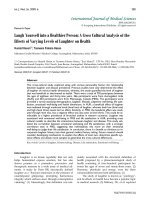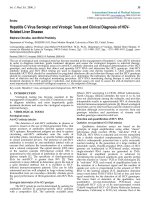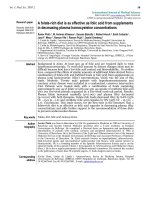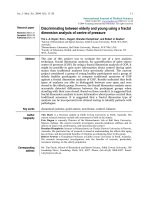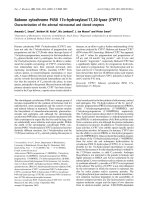Báo cáo y học: "TPO, but not soluble-IL-6 receptor, levels increase after anagrelide treatment of thrombocythemia in chronic myeloproliferative disorders"
Bạn đang xem bản rút gọn của tài liệu. Xem và tải ngay bản đầy đủ của tài liệu tại đây (216.76 KB, 5 trang )
Int. J. Med. Sci. 2008, 5
87
International Journal of Medical Sciences
ISSN 1449-1907 www.medsci.org 2008 5(2):87-91
© Ivyspring International Publisher. All rights reserved
Research Paper
TPO, but not soluble-IL-6 receptor, levels increase after anagrelide treat-
ment of thrombocythemia in chronic myeloproliferative disorders
Jan Palmblad
1
, Magnus Björkholm
2
, Jack Kutti
3
, Gerd Lärfars
4
, Eva Löfvenberg
1
, Berit Markevärn
5
, Mats
Merup
1
, Nils Mauritzson
6
, Jan Westin
6
, Jan Samuelsson
4
and
Gunnar Birgegård
7
1. Hematology Center, Karolinska University Hospital Huddinge, Stockholm
2. Hematology Center, Karolinska University Hospital Solna, Stockholm
3. Dept of Hematology, Sahlgrenska University Hospital, Göteborg
4. Dept of Medicine, Stockholm South Hospital, Stockholm
5. Dept of Medicine, University Hospital, Umeå
6. Dept of Hematology, University Hospital, Lund, Sweden
7. Dept of Medicine, University Hospital, Uppsala, for the Swedish MPD Study Group.
Correspondence to: Jan Palmblad, MD, PhD, Professor of Medicine, Dept. of Medicine, Karolinska University Hospital Huddinge, S-141
86 Stockholm, Sweden. Tel +46 8 5858 2693, fax +46 8 711 7684, e-mail address
Received: 2008.02.06; Accepted: 2008.04.13; Published: 2008.04.13
Anagrelide is often used in the treatment of thrombocythemia in myeloproliferative disease (MPD), but infor-
mation concerning effects of treatment on cytokines involved in regulation of blood platelet levels is limited.
Here, we investigated serum levels of thrombopoietin (TPO) and soluble IL-6 receptor (sIL-6R) in relation to re-
sponse to treatment with and plasma concentrations of anagrelide. Samples from 45 patients with thrombo-
cythemia due to MPD (ET=31, PV=14), being treated with anagrelide for 6 months, were analyzed for TPO,
sIL-6R and anagrelide levels. The mean baseline platelet count was 983x10
9
/L. A reduction of platelets to <600 in
asymptomatic or <400 x 10
9
/L in symptomatic patients was defined as a complete remission (CR), a reduction
with >50% of baseline as partial remission, and <50% reduction as failure. At 6 months, 35 patients were in CR, 1
had a partial remission and 9 were treatment failures. For all patients, there was an increase in TPO of 44% from
baseline; this change was more pronounced for patients with partial remission and failure. sIL-6R levels did not
change significantly. There was no correlation between levels of anagrelide and cytokine levels at 6 months, and
changes of cytokine levels did not relate to changes of platelet counts. Thus, a pronounced increase of TPO levels
after 6 months of anagrelide treatment indicated that this treatment affected a major regulatory mechanism for
megakaryocyte and platelet formation in MPD.
Key words: thrombocythemia, anagrelide, thrombopoietin, IL-6, soluble receptors
Introduction
One of the clinical challenges in chronic mye-
loproliferative disorders (MPD) is thrombocythemia,
always present in essential thrombocythemia (ET) and
often in polycythemia vera (PV), myelofibrosis (MF)
and chronic myelogenous leukemia. The risks associ-
ated with thrombocythemia are thromboembolic
events and bleeding, risks that may be reduced with
appropriate therapy.
Anagrelide hydroxide is a platelet reducing
compound, often used as an alternative to hydroxy-
urea, interferon-α and alkylating agents for the treat-
ment of thrombocytosis in MPD [1-4]. Anagrelide ex-
erts its effect by reducing differentiation at a late,
non-mitotic stage in megakaryocyte development
[5-8]. This leads to reduced platelet production by in-
hibition of megakaryocyte colony development,
thereby reducing megakaryocyte size and ploidy, and
disrupting or preventing full megakaryocyte matura-
tion. However, little is known of the interaction of
anagrelide with cytokines regulating thrombocyto-
poiesis, particularly thrombopoietin (TPO), the major
growth factor for regulation of blood platelet levels [9].
In a recent study a dose-response effect of anagrelide
on CD41 numbers and TPO-specific pTyr activity was
seen in vitro, indicating that anagrelide reduces the
TPO-mediated intracellular signaling events [10].
Serum or plasma levels of TPO are often, but not
always, raised in MPD [11-20; 21-25], with the highest
levels being observed in MF [24, 26]. Likewise, TPO
concentrations are often high in reactive thrombocyto-
sis [13, 14, 18, 22]. A few reports have described higher
TPO levels in treated compared to untreated MPD
patients [15, 17, 12]. In some of these studies, an in-
verse relation between blood platelet counts and TPO
was observed [16, 26] but just as often there was no
correlation [13, 19]. A role for TPO for emergence of
MF has also been suggested, based on results from
Int. J. Med. Sci. 2008, 5
88
studies with mice with engineered TPO overproduc-
tion [27-29]. Likewise, interleukin-6 (IL-6) levels might
be raised in MPD [14].
Since it is poorly known if therapy for thrombo-
cythemia affects TPO levels, we assessed the effects of
6 months of anagrelide treatment of thrombocytosis in
MPD patients on serum levels of TPO and the sIL-6
receptor. The latter was chosen since some recent evi-
dence has been presented indicating that high levels of
this receptor might be found in MPD and might be
lowered during anagrelide therapy [14, 30].
Results
Summary of clinical treatment results
A full description of these results is given in [3].
There was no significant difference in dose adminis-
tered to either the ET or PV patients (p=0.3). After 6
months of therapy, 45 patients were still taking ana-
grelide, 29 with ET and 16 with PV. 35 of these patients
had a CR, 1 a PR and 9 were failures. Serum samples
from these patients were analyzed for cytokine levels.
Fifteen patients of the original 60 had stopped ana-
grelide due to side effects or insufficient effect at tol-
erable dose.
Blood platelet levels
The starting venous blood platelet counts for the
45 patients of the ET and the PV groups are given in
Table 1, together with the platelet counts at 6 months.
All 45 patients displayed a similar drop of the platelet
count (Table 1). At start, there was no difference for the
platelet counts for those achieving CR and those who
did not (982 x 10
9
/L for both groups). The drop of the
platelet count over the 6 months was 50.3 % for all 45
MPD patients, 56.6 % for patients achieving CR and
29.4 % for the PR and F group (Figure 1). At 6 months,
the difference between the CR and the PR+F groups
(424±115 vs. 694±282) was statistically significant
(P<0.01).
Table 1. Platelet counts, serum TPO and sIL-6R concentrations
prior to and after 6 months of anagrelide treatment. Mean and
SD values.
Platelets,
x10
9
/L
At start After 6
months
P values
All MPD pts 983±312 488±201 <0.000001
ET only 1005±328 489±189
PV only 937±284 496±246
TPO, pg/mL
All MPD pts 71±89 103±100 0.00007
ET only 54.9±66.9 81.0±81.4
PV only 76.1±53.3 115±89.3
sIL-6R,
ng/mL
All MPD pts 38.5±9.9 37.4±8.4 0.087
ET only 36.7±9.4 36.0±7.6
PV only 42.2±10.9 41.0±9.6
0
+20
-40
-20
+40
+60
-60
All
CR
PR+F
P
e
r
c
e
n
t
c
h
a
n
g
e
f
r
o
m
s
t
a
r
t
Platelets
TPO
sIL-6R
Figure 1. Changes at 6 months in platelet counts, TPO and
sIL-6R concentrations in all MPD patients (All), in those
achieving complete response (CR) and those attaining partial
response or failure of response (PR+F), in relation to values
prior to start of anagrelide.
Anagrelide concentrations
At 6 months the mean anagrelide concentration in
plasma for the 45 MPD patients was 1.6±1.2 ng/mL.
There was no significant difference in anagrelide con-
centrations between PV and ET patients. Likewise,
there was no significant difference between those who
achieved CR or those with PR+F (not shown). Reliable
methods for the measurement of anagrelide metabo-
lites were not available at the time of study.
Effects on TPO and sIL-6R levels
TPO
PV and ET patients did not differ (p>0.05) at
baseline with regard to their TPO levels. Also at six
months the increments were similar in the two diag-
nosis groups (Table 1).
The mean serum concentration of this cytokine
increased with 44 % for all 45 MPD patients (P<0.00007
compared to base-line values)(Table 1 and Figure 1). In
CR patients, TPO levels rose slightly less, with 39.3 %
(P=0.0024), whereas PR and failure patients displayed
higher levels (57.7 %, P=0.013; Figure 1). Baseline TPO
values were somewhat lower for CR patients com-
pared to the PR+F group (68.4±100 vs. 78.9±49.5
pg/mL, respectively; p>0.05). Thus, the TPO concen-
tration at start did not indicate whether a patient
would obtain CR or not. Likewise, there was no statis-
tically significant difference at 6 months between those
achieving CR and those who did not (95.3±103 vs.
124±90.7 pg/mL; P>0.05).
Although the primary aim of this study was to
assess changes of cytokines during anagrelide treat-
Int. J. Med. Sci. 2008, 5
89
ment, some comparisons can be made with previously
published studies as to levels of TPO of MPD patients
compared to healthy individuals. Based on the studies
by others, who used the same assay system as we have
done [11, 23, 24], it appears that the starting TPO val-
ues for our MPD patients (mean values ± 2SD being
0-250 pg/mL) were similar to those published for
controls (combined mean values ± 2SD for the 3 stud-
ies: 0-221 pg/mL). The values at 6 months appeared,
however, to be higher (92.5-302 pg/mL).
sIL-6R
PV and ET patients did neither differ at baseline
nor at 6 months with regard to the sIL-6R levels (Table
1). No significant changes were observed for this
variable over the studied 6 months, neither for all pa-
tients, nor for those entering CR or PR+F (Figure 1).
The mean ± 2SD values for our patients at start
were slightly higher (28.6-58.3 ng/mL) than reported
by Marta et al [30] for their control subjects, being 0-38
ng/mL.
Correlations
There were no significant correlations (p>0.05)
between the magnitude of the change of platelet
counts, on the one hand, and changes of TPO or sIL-6R
concentrations, on the other. Neither were there any
significant correlations between changes of TPO or
sIL-6R concentrations.
Plasma anagrelide concentrations at 6 months did
neither correlate to either platelet counts, TPO or
sIL-6R concentrations at that time, nor to changes be-
tween time points 0 and 6 months for the latter three
variables.
Discussion
We report here that serum levels of TPO, the
major cytokine involved in the regulation of mega-
karyocyte and platelet growth and release, was raised
at six months of anagrelide treatment; concomitantly
there was a reduction of blood platelet counts. This rise
in serum concentrations of TPO is a novel finding and
may also be relevant for discussions about develop-
ment of bone marrow fibrosis during treatment with
anagrelide [4, 27-29, 31].
Previous investigations on TPO concentrations in
chronic myeloproliferative disorders have shown that
serum/plasma levels are slightly above or within the
range of normal individuals [11-25]. Our results agree
well with these previously published concentrations
when the same assay, as we used here, has been em-
ployed. That is true for base-line values, whereas val-
ues after 6 months appear to be well over the reference
range established by the others. Our findings might be
of help to explain why TPO values were higher than
normal in some studies and within the normal range in
other; it might be a matter of effects related to previous
treatments.
We cannot offer any mechanistic explanation for
why there was a rise in serum TPO levels. One specu-
lation relates to the model of action of TPO with its
receptor on target cells. It is well established that se-
rum levels of TPO are regulated by the binding of the
ligand to the receptor and the endocytosis of the
ligand-receptor complex [9]. Against that background,
we speculate that less TPO was bound to platelets and
more remained free when anagrelide caused a reduc-
tion in platelet concentrations. This hypothesis is
supported by the recent findings of McCarty et al, who
showed an effect of anagrelide on CD41 numbers and
TPO-specific pTyr activity in vitro, indicating that
anagrelide reduces the TPO-mediated intracellular
signaling events [10]. They suggest reduced receptor
binding as a possible mechanism. Furthermore, the
rise in TPO seen here may be analogous to what has
been described for the opposite, viz. the drop in TPO
that occurs when immunologic thrombocytopenic
purpura patients respond to therapy with raised
platelet counts. However, this hypothesis is not sup-
ported fully by the lack of correlation between the
changes for platelet counts and TPO concentrations.
Thus, those who displayed the most pronounced
platelet count reduction and achieving CR had the
lowest increase of TPO concentrations, whereas the
PR+F group showed the most pronounced rise of TPO.
Future studies of TPO interactions with its receptor,
not only on platelets but also on megakaryocytes,
might yield a better understanding [9].
One may ask if the TPO rise observed here was
specific for the anagrelide treatment or if it might also
be observed during treatment with hydroxyurea,
32
P,
interferon-α or other platelet reducing agents. At this
time this is not known; future longitudinal studies may
give an answer. However, the lack of correlation be-
tween TPO, on the one hand, and blood platelet
counts, on the other, is in accordance with some pre-
vious results [13,19]. This lack also suggests that in-
teractions are rather complex or slow; thus, in samples
obtained at a single time point it might not be feasible
to demonstrate cause-effect relationships, even if such
exist. Moreover, the lack of correlation between
changes of levels of the here measured cytokines with
levels of anagrelide is understandable, since the varia-
tion in maintenance dose was small (mean daily dose
at 6 months 2.3±0.2 mg) and the number of patients is
rather low. Moreover, recent data suggest that one
metabolite, BCH 24426, retains the platelet lowering
effect, whereas the other major metabolite, RL 603,
does not [8, 32]. When reliable analyses of metabolites
become available, such studies might shed some light
Int. J. Med. Sci. 2008, 5
90
on the drug-effect relations.
Soluble IL-6 receptor (IL-6R) was recently advo-
cated as a protein susceptible to reductions during
anagrelide treatment for MPD [30]. We can not cor-
roborate those findings here, despite using the same
assay as those investigators. At this time no clear ex-
planation for the discrepancies of results can be of-
fered.
Material and Methods
Patients
60 patients with a diagnosis of myeloproliferative
disease were treated with anagrelide (Agrylin®)[3]. 17
had polycythemia vera (PV), 42 essential thrombobo-
cythemia (ET) and 1 had myelofibrosis (MF). The di-
agnosis was established according to the diagnostic
criteria of Pearson et al for polycythemia vera [33] or
Kutti & Wadenvik [34] for essential thrombocythemia.
The platelet count had to be >600 x 10
9
/L in sympto-
matic patients or >1 000 x 10
9
/L in all other patients at
repeated measurements. Symptoms were defined as
previous thromboembolic episodes or ongoing micro-
circulatory symptoms
The mean age was 52.7, median 53.5 (27-75) years
for the whole group. Further details on demographics,
previous treatments etc are given in [3]. The study was
approved of the Ethical committee of Uppsala Univer-
sity and informed consent was obtained from all pa-
tients.
Treatment and response criteria
Full details of the treatment protocol are given in
[3]. Anagrelide was administered orally. The starting
dose was 0.5 mg b.i.d. If there was no response the
dose was increased by 0.5 mg per day per week. The
mean maintenance dose was 2.3 mg/day.
Complete response (CR) was defined as fulfill-
ment of the treatment goal of a platelet count
<
400 x
10
9
/L in symptomatic or <600 x 10
9
/L in asympto-
matic patients, respectively, for at least 4 weeks. Partial
response (PR) was defined as a reduction of the plate-
let count with at least 50 % of the baseline value, and
treatment failure (F) as a reduction of the platelet count
with < 50 % of the baseline value. Here, and for the
purpose of cytokine levels and platelet counts, we have
grouped PR and F together.
Laboratory methods
Blood counts were performed in the routine of
the hospital laboratories of clinical chemistry.
Serum and plasma samples were collected at
baseline and after 6 months of therapy and stored at
–70
o
C until analyzed. Only patients completing the 6
months of therapy were included.
Serum TPO and soluble IL-6 receptor (sIL-6R)
concentrations were measured with ELISA (Quanti-
kine, R&D Systems, Minneapolis, MN), as recom-
mended by the manufacturer and in duplicates. The
lower limits of detection were for TPO 8 pg/mL and
for sIL-6R 6.5 pg/mL. There is no difference between
serum and plasma levels of these two cytokines, ac-
cording to the information provided by the manufac-
turer.
Anagrelide plasma concentrations were analyzed
by York Bioanalytical Solutions, UK with a spectro-
metric method.
Statistical methods
Changes in concentration of cytokines were
tested with T-test for dependent samples. Values are
given as mean and SD values (or as indicated). Corre-
lations between variables were assessed with Pearson
correlation test.
Acknowledgment
This study was carried out with the support of an
unrestricted research grant from Swedish Orphan AB
and grants from The Swedish Medical Research
Council 71X-5991 (to JP). We thank Inger Vedin, MSci,
for the cytokine analyses, and Dr Terry Noctor, York
Bioanalytical Solutions, UK, for the anagrelide con-
centration analyses.
Conflict of interest
The authors have declared that no conflict of in-
terest exists.
References
1. Anagrelide study group. Anagrelide, a therapy for thrombo-
cythemic states: experience in 577 patients. Am J Med
1992;92:69-78.
2. Storen EC, Tefferi A. Long-term use of anagrelide in young
patients with essential thrombocythemia. Blood 2001;97:863-6.
3. Birgegard G, Bjorkholm M, Kutti J, Larfars G, Lofvenberg E,
Markevarn B, Merup M, Palmblad J, Mauritzson N, Westin J,
Samuelsson J. Adverse effects and benefits of two years of ana-
grelide treatment for thrombocythemia in chronic myeloprolif-
erative disorders. Haematologica 2004;89:520-7.
4. Harrison CN, Campbell PJ, Buck G, Wheatley K, East CL, Bare-
ford D, Wilkins BS, van der Walt JD, Reilly JT, Grigg AP, Revell
P, Woodcock BE, Green AR; United Kingdom Medical Research
Council Primary Thrombocythemia 1 Study. Hydroxyurea
compared with anagrelide in high-risk essential thrombocythe-
mia. N Engl J Med 2005;353:33-45
5. Mazur EM, Rosmarin AG, Sohl PA et al. Analysis of the mecha-
nism of anagrelide-induced thrombocytopenia in humans. Blood
1992;79:1931-7.
6. Bellucci S, Legrand C, Boval B, Drouet L, Caen J. Studies of
platelet volume, chemistry and function in patients with essen-
tial thrombocythemia treated with anagrelide. Br J Haematol
1999;104:886-892
7. Tomer A. Effects of anagrelide on invivo megakaryocyte prolif-
eration and maturation in essential thrombocythemia. Blood
2002; 99: 1602-9.
8. Hong Y, Wang G, Del Arroyo AG, Hernandez J, Skene C, Eru-
salimsky JD. Comparison between anagrelide and hydroxycar-
Int. J. Med. Sci. 2008, 5
91
bamide in their activities against haematopoietic progenitor cell
growth and differentiation: selectivity of anagrelide for the
megakaryocytic lineage. Leukemia 2006;20:1117-22.
9. Kaushansky K. The molecular mechanisms that control throm-
bopoiesis. J Clin Invest 2005;115:3339-47
10. McCarty JM, Melone PD, Simanis JP, Kanamori D, Dessypris
EN, Warshamana-Greene S. A preliminary investigation into the
action of anagrelide: Thrombopoietin-c-Mpl receptor interac-
tions. Exp Haematology 2006;34:87-96.
11. Hou M, Carneskog J, Mellqvist UH, Stockelberg D, Hedberg M,
Wadenvik H, Kutti J. Impact of endogenous thrombopoietin
levels on the differential diagnosis of essential thrombocythae-
mia and reactive thrombocytosis. Eur J Haematol 1998;61:119-22.
12. Griesshammer M, Hornkohl A, Nichol JL, Hecht T, Raghavachar
A, Heimpel H, Schrezenmeier H. High levels of thrombopoietin
in sera of patients with essential thrombocythemia: cause or
consequence of abnormal platelet production? Ann Hematol
1998;77:211-5.
13. Cerutti A, Custodi P, Duranti M, Noris P, Balduini CL. Throm-
bopoietin levels in patients with primary and reactive throm-
bocytosis. Br J Haematol 1997;99:281-4.
14. Hsu HC, Tsai WH, Jiang ML, Ho CH, Hsu ML, Ho CK, Wang SY.
Circulating levels of thrombopoietic and inflammatory cyto-
kines in patients with clonal and reactive thrombocytosis. J Lab
Clin Med 1999;134:392-7
.
15. Griesshammer M, Kubanek B, Beneke H, Heimpel H, Bangerter
M, Bergmann L, Schrezenmeier H. Serum erythropoietin and
thrombopoietin levels in patients with essential thrombo-
cythaemia. Leuk Lymphoma 2000;36:533-8
16. Tomita N, Motomura S, Sakai R, Fujimaki K, Tanabe J, Fukawa
H, Harano H, Kanamori H, Ogawa K, Mohri H, Maruta A, Ko-
dama F, Ishigatsubo Y, Tahara T, Kato T. Strong inverse correla-
tion between serum TPO level and platelet count in essential
thrombocythemia. Am J Hematol 2000;63:131-5.
17. Andreasson B, Lindstedt G, Stockelberg D, Wadenvik H, Kutti J.
The relation between plasma thrombopoietin and erythropoietin
concentrations in polycythaemia vera and essential thrombo-
cythaemia. Leuk Lymphoma. 2001;41:579-84
18. Karakus S, Ozcebe OI, Haznedaroglu IC, Goker H, Ozatli D,
Kosar A, BuyukasIk Y, Ertugrul D, SayInalp N, KirazlI S,
Dundar SV. Circulating thrombopoietin in clonal versus reactive
thrombocytosis. Hematology 2002;7:9-12.
19. Werynska B, Ramlau R, Podolak-Dawidziak M, Jankowska R,
Prajs I, Usnarska-Zubkiewicz L, Kuliczkowski K.
Serum
thrombopoietin levels in patients with reactive thrombocytosis
due to lung cancer and in patients with essential thrombo-
cythemia. Neoplasma 2003;50:447-51.
20. Akiyama T, Matsunaga T, Terui T, Miyanishi K, Tanaka I, Sato T,
Kuroda H, Takimoto R, Takayama T, Kato J, Yamauchi N, Ko-
gawa K, Sakamaki S, Hirayama Y, Kohda K, Niitsu Y. Involve-
ment of transforming growth factor-beta and thrombopoietin in
the pathogenesis of myelodysplastic syndrome with myelofi-
brosis. Leukemia 2005;19:1558-66
21. Hirayama Y, Sakamaki S, Matsunaga T, Kuga T, Kuroda H, Ku-
sakabe T, Sasaki K, Fujikawa K, Kato J, Kogawa K, Koyama R,
Niitsu Y. Concentrations of thrombopoietin in bone marrow in
normal subjects and in patients with idiopathic thrombocyto-
penic purpura, aplastic anemia, and essential thrombocythemia
correlate with its mRNA expression of bone marrow stromal
cells. Blood 1998;92:46-52.
22. Uppenkamp M, Makarova E, Petrasch S, Brittinger G. Throm-
bopoietin serum concentration in patients with reactive and
myeloproliferative thrombocytosis. Ann Hematol
1998;77:217-23.
23. Espanol I, Hernandez A, Cortes M, Mateo J, Pujol-Moix N. Pa-
tients with thrombocytosis have normal or slightly elevated
thrombopoietin levels. Haematologica 1999;84:312-6.
24. Panteli KE, Hatzimichael EC, Bouranta PK, Katsaraki A, Seferi-
adis K, Stebbing J, Bourantas KL. Serum interleukin (IL)-1, IL-2,
sIL-2Ra, IL-6 and thrombopoietin levels in patients with chronic
myeloproliferative diseases. Br J Haematol 2005;130:709-15
25. Randi ML, Putti MC, Pacquola E, Luzzatto G, Zanesco L, Fabris
F. Normal thrombopoietin and its receptor (c-mpl) genes in
children with essential thrombocythemia. Pediatr Blood Cancer
2005;44:47-50
26. Elliott MA, Yoon SY, Kao P, Li CY, Tefferi A. Simultaneous
measurement of serum thrombopoietin and expression of
megakaryocyte c-mlp with clinical and laboratory correlates for
myelofibrosis with myeloid metaplasia. Eur J Haematol
2002;68:175-9.
27. Yan XQ, Lacey D, Hill D, Chen Y, Fletcher F, Hawley RG,
McNiece IK.. A model of myelofibrosis and osteosclerosis in
mice induced by overexpressing thrombopoietin (mpl ligand):
reversal of disease by bone marrow transplantation. Blood
1996;88:402-9.
28. Kakumitsu H, Kamezaki K, Shimoda K, Karube K, Haro T,
Numata A, Shide K, Matsuda T, Oshima K, Harada M. Trans-
genic mice overexpressing murine thrombopoietin develop
myelofibrosis and osteosclerosis. Leuk Res 2005;29:761-9.
29. Vannucchi AM, Bianchi L, Paoletti F, Pancrazzi A, Torre E, Ni-
shikawa M, Zingariello M, Di Baldassarre A, Rana RA, Lorenzini
R, Alfani E, Migliaccio G, Migliaccio AR. A pathobiologic path-
way linking thrombopoietin, GATA-1, and TGF-beta1 in the
development of myelofibrosis.Blood 2005 ;105:3493-501
30. Marta R, Goette N, Lev P, Heller P, Kornblihtt L, Vassallu P,
Glembotsky A, Pirola C, Molinas F. Increased levels of plasma
interleukin-6 soluble receptor in patients with essential throm-
bocythemia. Haematologica 2004;89:657-63
31. Chagraoui H, Komura E, Tulliez M, Giraudier S, Vainchenker
W, Wendling F. Prominent role of TGF-beta 1 in thrombopoi-
etin-induced myelofibrosis in mice. Blood 2002;100:3495-503
32. Erusalimsky JD, Franklin R and Hong Y. Is the platelet lowering
activity of anagrelide mediated by its major metabolite
2-amino-5,6-dichloro-3,4-dihydroquinazoline (RL603)? Exp
Haematol 2002;30:625-6
33. Pearson TC, Messinezy M, Westwood N, Green AR, Bench AJ,
Huntly BJ, Nacheva EP, Barbui T, Finazzi G. A Polycythemia
Vera Updated: Diagnosis, Pathobiology, and Treatment. Hema-
tology Am Soc Hematol Educ Program. 2000;:51-68.
34. Kutti J, Wadenvik H. Diagnostic and differential criteria of es-
sential thrombocythemia and reactive thrombocytosis. Leuk
Lymphoma 1996;22:41-3.
